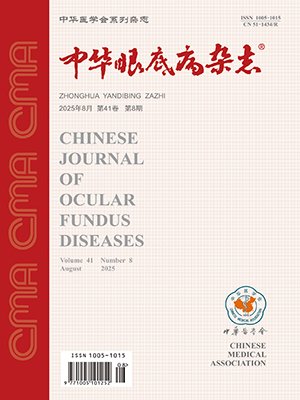| 1. |
Mi H, Ho SL, Lim WK, et al. Trends in patterns of posterior uveitis and panuveitis in a tertiary institution in Singapore[J]. Ocul Immuno Inflamm, 2015, 23(4): 329-338. DOI: 10.3109/09273948.2014.946148.
|
| 2. |
Cheung CSY, Jekielek A, Bakshi N, et al. Clinical features of infectious posterior segment uveitis[J]. Can J Ophthalmol, 2018, 53(4): 425-431. DOI: 10.1016/j.jcjo.2017.11.004.
|
| 3. |
Abaño JM, Galvante PR, Siopongco P, et al. Review of epidemiology of uveitis in Asia: pattern of uveitis in a tertiary hospital in the Philippines[J]. Ocul Immunol Inflamm, 2017, 25(Sup1): S75-80. DOI: 10.1080/09273948.2017.1335755.
|
| 4. |
Khochtali S, Gargouri S, Zina S, et al. Acute multifocal retinitis: a retrospective review of 35 cases[J]. J Ophthalmic Inflamm Infect, 2018, 8(1): 18. DOI: 10.1186/s12348-018-0160-9.
|
| 5. |
Yen YF, Feng TY, Yi-Fong Su V, et al. Human immunodeficiency virus infection increases the risk of incident uveitis among people living with HIV/AIDS[J]. J Acquir Immune Defic Syndr, 2018, 79(2): 149-157. DOI: 10.1097/QAI.0000000000001782.
|
| 6. |
Schaftenaar E, Meenken C, Baarsma GS, et al. Uveitis is predominantly of infectious origin in a high HIV and TB prevalence setting in rural South Africa[J]. Br J Ophthalmol, 2016, 100(10): 1312-1316. DOI: 10.1136/bjophthalmol-2016-308645.
|
| 7. |
Smit DP, Esterhuizen TM, Meyer D, et al. The etiology of intraocular inflammation in HIV positive and HIV negative adults at a tertiary hospital in Cape Town, South Africa[J]. Ocul Immunol Inflamm, 2019, 27(2): 203-210. DOI: 10.1080/09273948.2018.1476555.
|
| 8. |
Mwanza J, Kayembe D. Uveitis in HIV-infected patients[J]. Eur J Ophthalmol, 2001, 11(1): 53-56. DOI: 10.1177/112067210101100110.
|
| 9. |
Scheepers MA, Lecuona KA, Rogers G, et al. The value of routine polymerase chain reaction analysis of intraocular fluid specimens in the diagnosis of infectious posterior uveitis[J/OL]. Scientific World Journal, 2013, 2013: 545149[2013-10-22]. http://europepmc.org/abstract/MED/24250270. DOI: 10.1155/2013/545149.
|
| 10. |
Harper TW, Miller D, Schiffman JC, et al. Polymerase chain reaction analysis of aqueous and vitreous specimens in the diagnosis of posterior segment infectious uveitis[J]. Am J Ophthalmol, 2009, 147(1): 140-147. DOI: 10.1016/j.ajo.2008.07.043.
|
| 11. |
Pathanapitoon K, Kongyai N, Sirirungsi W, et al. The diagnostic value of intraocular fluid analysis by polymerase chain reaction in Thai patients with uveitis[J]. Trans R Soc Trop Med Hyg, 2011, 105(11): 650-654. DOI: 10.1016/j.trstmh.2011.08.003.
|
| 12. |
Kumar A, Singh MP, Bansal R, et al. Development and evalution of multiplex real-time PCR for diagnosis of HSV-1, VZV, CMV, and toxoplasma gondii in patients with infectious uveitis[J]. Diagn Microbiol Infect Dis, 2017, 89(3): 191-196. DOI: 10.1016/j.diagnmicrobio.2017.08.002.
|
| 13. |
Sandhu HS, Hajrasouliha A, Kaplan HJ, et al. Diagnostic utility of quantitative polymerase chain reaction versus culture in endophthalmitis and uveitis[J]. Ocul Immunol Inflamm, 2019, 27(4): 578-582. DOI: 10.1080/09273948.2018.1431291.
|
| 14. |
Rose-Nussbaumer J, Goldstein DA, Thorne JE, et al. Uveitis in human immunodefificiency virus-infected persons with CD4+ T-lymphocyte count over 200 cells/ml[J]. Clin Exp Ophthalmol, 2014, 42(2): 118-125. DOI: 10.1111/ceo.12141.
|




